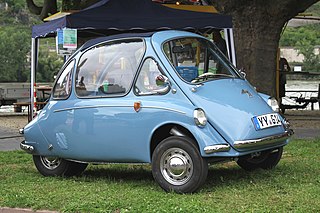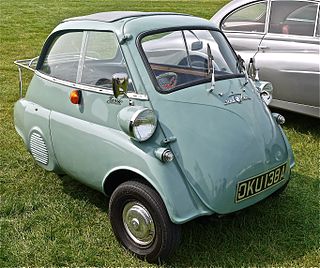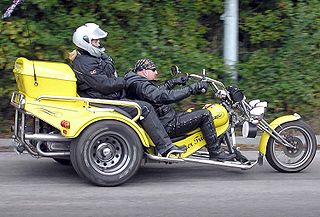Related Research Articles

Microcar is a term often used for the smallest size of cars, with three or four wheels and often an engine smaller than 700 cc (43 cu in). Specific types of microcars include bubble cars, cycle cars, invacar, quadricycles and voiturettes. Microcars are often covered by separate regulations to normal cars, having relaxed requirements for registration and licensing.

An antique car is an automobile that is an antique. Narrower definitions vary based on how old a car must be to qualify. The Antique Automobile Club of America defines an antique car as over 25 years of age. However, the legal definitions for the purpose of antique vehicle registration vary widely. The antique car era includes the Veteran era, the Brass era, and the Vintage era, which range from the beginning of the automobile up to the 1930s. Later cars are often described as classic cars. In original or originally restored condition antiques are very valuable and are usually either protected and stored or exhibited in car shows but are very rarely driven.

The Isetta is an Italian-designed microcar built under license in a number of different countries, including Argentina, Spain, Belgium, France, Brazil, Germany, and the United Kingdom. Because of its egg shape and bubble-like windows, it became known as a bubble car, a name also given to other similar vehicles.

A three-wheeler is a vehicle with three wheels. Some are motorized tricycles, which may be legally classed as motorcycles, while others are tricycles without a motor, some of which are human-powered vehicles and animal-powered vehicles.
V Cars. LLC, called Visionary Vehicles prior to mid-2008, was an international automobile import and distribution company, founded by Malcolm Bricklin and engaging in the development and sale of Chinese-made motor vehicles in North America. The company closed down prior to ever importing any cars to North America.

Crude ideas and designs of automobiles can be traced back to ancient and medieval times. In 1649, Hans Hautsch of Nuremberg built a clockwork-driven carriage. In 1672, a small-scale steam-powered vehicle was created by Ferdinand Verbiest; the first steam-powered automobile capable of human transportation was built by Nicolas-Joseph Cugnot in 1769. Inventors began to branch out at the start of the 19th century, creating the de Rivaz engine, one of the first internal combustion engines, and an early electric motor. Samuel Brown later tested the first industrially applied internal combustion engine in 1826. Only two of these were made.

Clyno Engineering Company, later Clyno Engineering Company (1922) Ltd, was a motorcycle and car manufacturer that operated in Thrapston from 1909 to 1910 and then in Wolverhampton from 1910 to 1929. During this time they produced over 15,000 motorcycles and between 36,000 and 40,000 cars, at one point becoming Britain's third largest car manufacturer.
The automotive industry in India is the world's fourth-largest by production and valuation as per 2022 statistics. As of 2023, India is the 3rd largest automobile market in the world in terms of sales.

A high wheeler is a car which uses large diameter wheels that are similar to those used by horse-drawn vehicles. These cars were produced until about 1915, predominantly in the United States.
The Autoette was an electric microcar manufactured from the late 1930s to the 1970s. The two-seat, three-wheeled microcar was steered by tiller and powered by specially made batteries from Trojan Battery Co., with motive power provided by a converted 24-volt Dodge 1½ hp. electric starter motor and later a proprietary motor built for Autoette. Models included the "CruiseAbout", "Golfmobile" and "Electric Truck".

The Star Motor Company was a British car and commercial vehicle maker based in Wolverhampton and active from 1898 to 1932. At its peak Star was the UK's sixth largest car manufacturer and produced around 1000 cars a year.
The powertrain layout of a motorised vehicle such as a car is often defined by the location of the engine or motors and the drive wheels.
The following outline is provided as an overview of and topical guide to automobiles:
A car, or an automobile, is a motor vehicle with wheels. Most definitions of cars state that they run primarily on roads, seat one to eight people, have four wheels, and mainly transport people over cargo. There are around one billion cars in use worldwide.

Lohner–Porsche is a term encompassing several electric vehicles designed by Ferdinand Porsche and manufactured at Lohner-Werke in the early 1900s. They include the first hybrid electric vehicle and the first commercial hub motor car. The hybrid "Mixed" or "Mixte" racecars are powered by a gasoline engine which drives four electric motors, one in each wheel hub. The battery-powered "Touring" or "Chaise" commercial cars utilize only two front-wheel hub motors.
This is a chronological index for the start year for motor vehicle brands. For manufacturers that went on to produce many models, it represents the start date of the whole brand; for the others, it usually represents the date of appearance of the main model that was produced.

A motorized tricycle, motor trike, or motortrycle is a three-wheeled vehicle based on the same technology as a motorcycle, and powered by an electric motor, motorcycle, scooter or car engine.

The automotive industry in Sweden is mainly associated with passenger car manufacturers Volvo Cars and Saab Automobile but Sweden is also home of two of the largest truck manufacturers in the world: AB Volvo and Scania AB. The automotive industry is heavily dependent on export as some 85 percent of the passenger cars and 95 percent of the heavy vehicles are sold outside of Sweden. The automotive industry and its sub-contractors is a major part of Swedish industry. In 2011 around 110,000 people were employed and the export income of 150 billion SEK accounted for 12 per cent of Sweden's export income. During 2009 128,738 passenger cars and 27,698 heavy vehicles were built in Sweden. Koenigsegg is also a famous Swedish company which makes some of the fastest cars in the world, but also some of the most expensive. They currently produce models such as the Jesko, Gemera, and CC850.
Pakistan has a significant market for hybrid vehicles such as Honda's Vezel, Toyota's Prius, and Aqua. The Automotive Development Policy (2016–2021) and the launch of the China-Pakistan Economic Corridor (CPEC) encourage foreign investments for new automobile brands to enter the Pakistani market.
Takeoka Auto Craft Co. Ltd., commonly known as Takeoka, is a Japanese automobile manufacturer that specializes in microcars.
References
- David Burgess Wise, The New Illustrated Encyclopedia of Automobiles.
- Bushbury Electric on 3-Wheelers.com